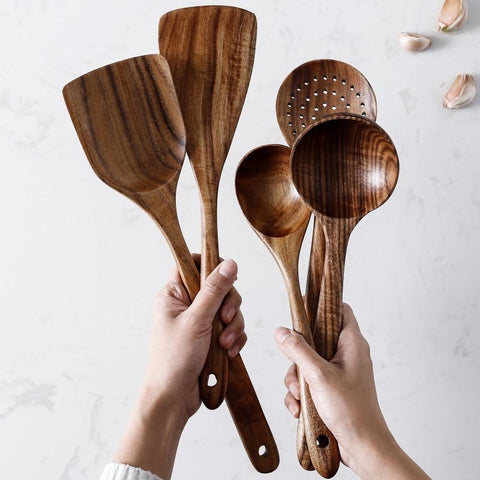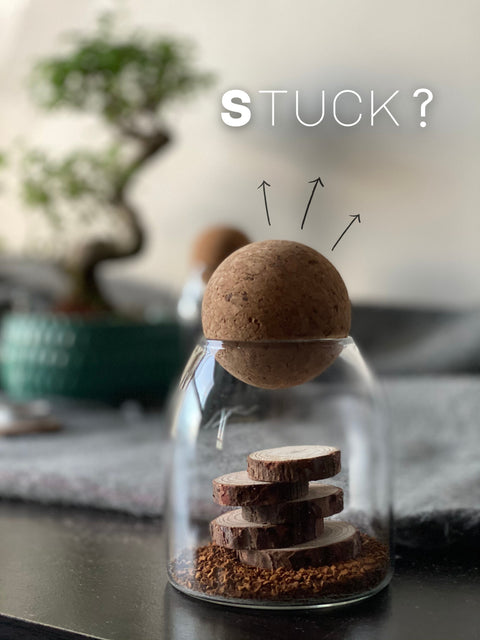 Introduction:
Introduction:

Why Is Wood Still Used For Kitchenware?
Wood was one of the very first materials used by humans, among its many uses was for preparing, cooking and serving food. It’s no coincidence that thousands of years on, all around the world it’s still used to this day in our kitchens.
Did you ever wonder why butchers and chefs all still use wooden chopping blocks? Apart from the fact that wood has far less of a blunting-effect on knife blades, wood actually has higher anti-bacterial properties than many human-made materials such as plastic.
There have even been many studies on this, and while plastic is not unsafe to use for cutting boards, it has been proven that wood is far less likely to contain or allow bacteria growth than plastic.
What's more is that wood’s surface can be easily sealed, sanded and repaired to remove any dents or deep scratches that may be more inviting to those pesky little bacteria. In most cases, plastic and other materials cannot be easily repaired over and over.
How Is Wood Anti-Bacterial?
Trees naturally fight bacteria, mould and other infections while they are growing. Of course, once a piece of wood is shaped into a board, bowl, plate or utensil, it's no longer a living organism, but the properties and the structure of the wood are still the same.
That is to say: wood has cells that don't grow bacteria or mould.
The natural oils that are then applied to seal wooden kitchenware creates an inert or neutral surface on top where bacteria also cannot survive.
Now that you know a little more about why wood works so well for kitchenware, here's how you should care for your wooden cutting boards, bowls, plates, cups and other wooden kitchen utensils:
Caring For Wooden Kitchenware:
Washing, Drying & Oiling
How Should You Wash Wooden Kitchenware?
It’s always recommended to hand-wash your wooden kitchenware after use with hot water and a mild dish soap.
Can You Put Wooden Kitchenware In The Dishwasher?
If you’re in a pinch, or you truly despise washing dishes by hand, you can also put most wooden cutting boards and other wooden kitchenware in the dishwasher. Just remember to use the lowest temperature setting and the shortest washing-cycle to limit the risk of any wear and tear on the wood.
What Cloth Should You Wash Wooden Kitchenware With?
Most dish sponges or clothes are totally fine. Tougher species of wood such as acacia and walnut can take a good bit more of a scrubbing than softer woods like pine or spruce can (which are often used for cheaper wooden spoons and utensils).
In general, try to avoid very abrasive dish scourers and steel-scrubbers when washing any wooden kitchenware.
Can You Soak Wooden Cutting Boards & Utensils?
Avoid leaving any wooden cutting boards, dishes or utensils soaking in water for long periods of time as it can lead to cracks developing in the wood and a fading of the natural pigment.
How To Dry Wooden Kitchenware:
Dab them dry with a clean dish towel and allow them to fully air-dry before putting them away for storage. This can sometimes up to a few hours depending on the climate you're in.
Should You Oil Your Wooden Kitchenware?
This mainly depends on two factors: the climate you live in and the amount of use your wooden kitchenware gets.
Repeated washing, soaps, oils and climate conditions will draw oil from the wood, eventually causing it to lose some of its vibrance, appear faded or even show cracks in places.
Over time, if you notice that the wood is starting to dry out, feels less smooth or begins to show some cracks, you can periodically apply some natural oil or wax to reseal it. This will also bring back a new lease of life to your wood, visually speaking.
What Is The Best Oil To Use?
We recommend using beeswax, olive oil, coconut oil, or linseed oil. All of these options are 100% food-safe, easily available and will provide long lasting protection for your wooden kitchenware.
How Do You Oil Wooden Kitchenware?
1. Make sure the wood is clean and dry. Be sure to wash your cutting boards, bowls, plates and utensils and allow them to thoroughly dry before applying any oil. Unfortunately, the oil won't absorb into the wood properly if it's still wet beforehand.
2. Apply the natural oil or wax. Using a clean, soft cloth, paper towel, or paint brush, apply the oil or wax liberally onto the wood in an even layer.
3. Let the oil do its magic. Allow your natural oil or beeswax to absorb into the wood for about 4 - 12 hours (until it feels dry to the touch).
4. Remove the excess on the surface. If there is still any excess oil or beeswax on the surface of the wood after this time, you can wipe it off with a paper towel or cloth. If it still feels sticky or damp after this, leave it dry out for another few hours in a well-ventilated space.
How Often Should You Oil It?
Again, how frequently you should oil your wooden kitchenware will depend on how much use it gets and which type of climate you live in.
If you live in a drier climate and use your wooden kitchenware multiple times a day, for best results you could oil the most-used wooden pieces every 3-6 months.
If you're living in a cooler, wetter or more humid climate, and your wooden cutting boards, bowls and utensils are also used daily, it's probably best to oil them every 6-12 months.
It's something that you will start to notice as you're using your kitchenware, if some cutting boards are starting to look a little less shiny than the day you bought them, perhaps it's time to give them a quick oiling or waxing.
Does Wooden Kitchenware Get Stained?
Foods that contain a lot of pigment, such as tomatoes, red peppers or berries can leave stains on wooden boards and utensils. They’re still completely safe to use and typically most stains will naturally fade away after a couple of washes.
One thing to note is that the smoother the surface of the wooden board, bowl or utensil, the easier it will be to wash a stain off it - and it's also less likely to get stained in the first place.
How Do You Remove Stains From Wooden Kitchenware?
Most stains will easily wash out of wood after a few washes. If your wooden cutting board has a particularly persistent stain on it that will not wash out, you can use either a 50/50 mixture of baking soda and water, or a non-gel toothpaste and tooth brush to scrub the area.
If none of these methods work, you can always sand away the stain and then re-apply oil to the sanded area.
How Do I Remove Blemishes, Scuffs, Scratches and Tougher Stains?
As wooden kitchenware is intended to last many years and endure a lot of use, over time you may get some scuffs, rough patches or maybe even a really tough stain that just won’t seem to budge. If this happens, the great thing about wood is that it is malleable and repairable, here’s what to do:
1. When the wood is dry, use some fine-grained sandpaper to gently sand the surface where the scuff or stain is, be sure to always sand in the same direction as the natural grain of the wood, rather than perpendicular to it.
2. Wipe away the dust with a damp cloth and allow it to dry, or vacuum the dust instead if you are in a hurry!
3. Re-seal the wood with any natural oil.
- Just as is outlined above, use a clean cloth or paper towels to apply the oil or wax on to the surface of the wood.
- Allow the oil or beeswax to absorb into the wood for about 4 - 12 hours (until it feels dry to the touch). If there is any excess oil or wax on the surface of the wood after this time, wipe it off with a paper towel or cloth.
How Do I Remove Strong Odours From Wooden Kitchenware?
Some stronger odours from foods such as garlic can be absorbed by wooden boards and utensils over time. This is usually more common with wooden spoons if they are left soaking in a sauce on the stove while cooking.
- To remove any strong smells from the wood, you can scrub the utensil or cutting board with some lemon juice - or any citrus juice for that matter!
- Allow it to sit for 30-60 seconds (or longer if you wish) before rising it off with water. This can also be done by using a mixture of baking soda and water instead of citrus juice.
There you have it! With these tips, your wooden kitchenware will last you a lifetime, if not longer!

















Comments (0)
There are no comments for this article. Be the first one to leave a message!